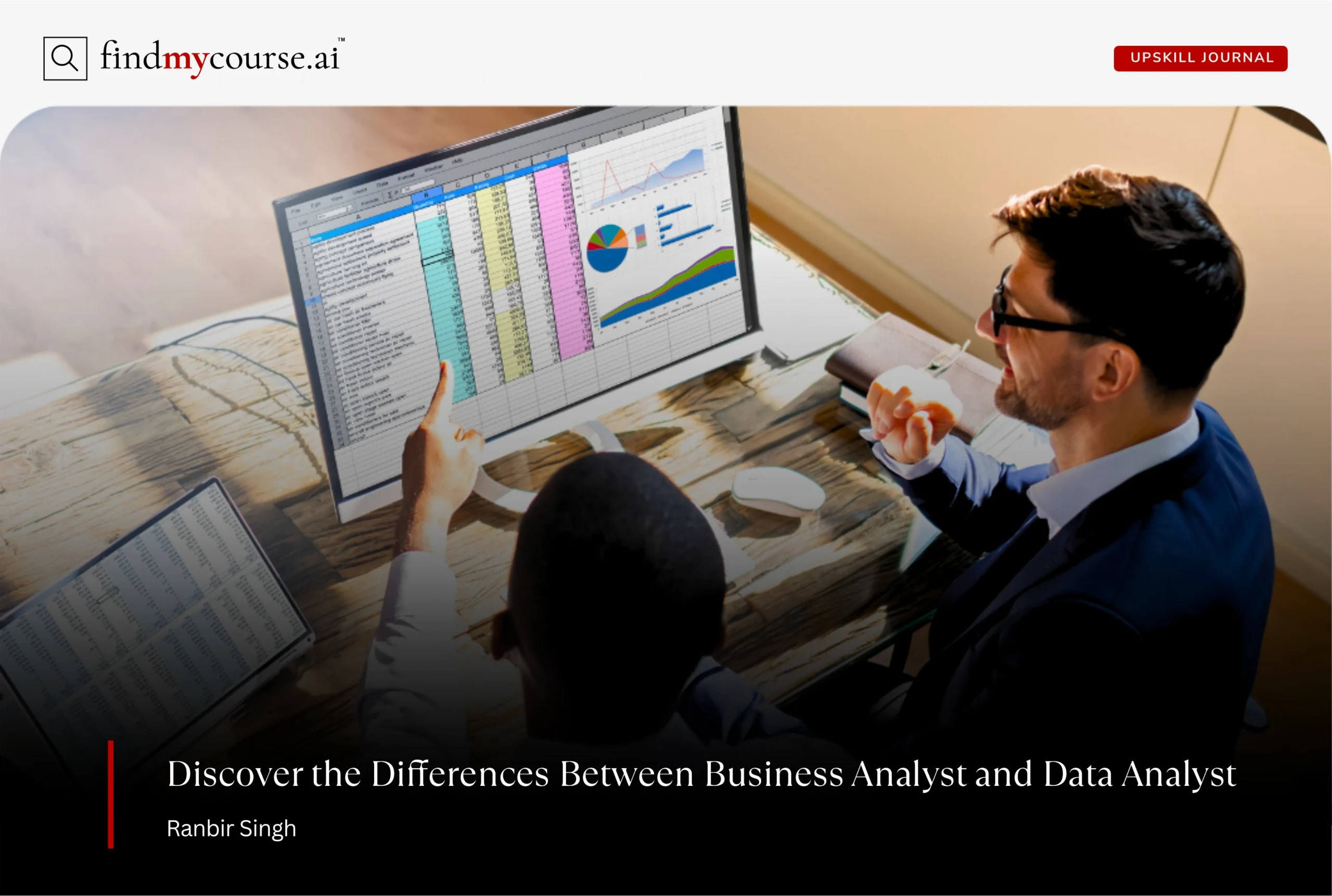Imagine walking into a company meeting where everyone is talking about “data-driven decisions.” You’ll hear two titles pop up again and again—business analyst and data analyst. Both sound analytical, both sound important… but what do they actually do? These two roles have become pillars of modern business success. Every organization today relies on them to understand performance, improve systems, and stay competitive. Yet, despite how often they work together, many professionals still confuse one for the other. So, what’s the real difference between business analyst vs data analyst?
In this guide, we’ll break it down in simple terms—what each role does, the skills they need, their tools, salaries, and how you can upskill to start a rewarding career in either direction. Whether you’re just beginning your career or planning a switch, this comparison will help you confidently decide which path fits your strengths and ambitions in 2025.
What Does a Business Analyst Do?
Business analysts are the architects of business improvement. They explore how organizations operate, collaborate with stakeholders, and uncover challenges that prevent teams from performing at their best. Their goal is not just to identify problems, but to design actionable solutions that improve efficiency and align with business objectives.
A typical day may involve meeting with teams to understand pain points, mapping workflows, or coordinating with managers to implement new processes. In 2025, business analysts are especially valuable in guiding companies through digital transformation, helping them adapt to smarter operational strategies and evolving business needs.
This career suits individuals who enjoy problem-solving, strategic thinking, and working closely with people to drive meaningful change.
What Does a Data Analyst Do?
Data analysts are the detectives of the business world. They examine information to uncover patterns, trends, and insights that guide smarter business decisions. Their focus is on translating complex information into actionable insights that stakeholders can rely on.
On a typical day, data analysts interpret datasets, identify trends, and provide clear recommendations that help companies optimize operations and measure success. They play a key role in making sure data is not just collected but used to inform strategy and performance improvements.
This role is ideal for those who enjoy independent analytical work, have a keen eye for detail, and take satisfaction in turning numbers into stories that drive business growth.
Business Analyst vs Data Analyst: Key Differences
Now, let’s break down the difference between business analyst and data analyst in a simple, side-by-side view.
| Aspect | Business Analyst | Data Analyst |
| Main Goal | Improves how a business operates by identifying problems, defining requirements, and recommending strategies that boost efficiency and profitability. | Uncovers insights within data by analyzing patterns, trends, and metrics to support smarter, evidence-based decisions. |
| Primary Focus | Concentrates on people, processes, and systems—understanding how departments work together and how changes can enhance performance. | Focuses on data, tools, and numbers—collecting, cleaning, and interpreting large datasets to explain what’s happening and why. |
| Core Skills | Strong in communication, documentation, and strategic thinking. Skilled at translating business needs into actionable plans. | Proficient in SQL, Python, Excel, and data visualization. Skilled at transforming raw data into meaningful insights. |
| Typical Output | Produces business cases, process maps, and requirement documents that guide change and improve operations. | Creates dashboards, reports, and visual summaries that highlight performance trends and key opportunities. |
| Mindset | Strategic and collaborative—focused on solving problems through people and processes. | Analytical and technical—driven by curiosity and precision to find truth in data. |
A business analyst looks at what needs to change.
A data analyst explains why things are happening.
That’s the simplest way to remember the difference between data analyst and business analyst roles.
Business Analyst vs Data Analyst: Essential Tools and Tech in 2025
Technology is at the heart of both roles, but the type of tools each professional uses reflects their unique purpose. A business analyst focuses on improving systems and workflows, while a data analyst uses technology to uncover and visualize insights. Understanding these toolsets helps you see how the two roles complement each other in today’s data-driven world.
| Tool Type | Business Analyst Tools | Data Analyst Tools |
| Data Handling & Analysis | Microsoft Excel for modeling and reporting; CRM or ERP systems to analyze business performance. | SQL and Python for data manipulation; cloud tools like AWS and BigQuery for managing large-scale data. |
| Visualization & Mapping | Lucidchart or Visio for mapping workflows and processes; Excel for visual summaries. | Tableau or Power BI for creating interactive dashboards and visual analytics. |
| Project & Collaboration | Jira or Trello for tracking tasks, managing requirements, and collaborating with teams. | Google Sheets and shared dashboards for cross-team collaboration and real-time reporting. |
As organizations continue to evolve, the business analyst and data analyst toolkits increasingly overlap. Business analysts now use dashboards to validate their recommendations, while data analysts develop a deeper understanding of business goals to ensure their insights drive meaningful change.
How to Choose the Right Path
Choosing between business analyst vs data analyst can feel overwhelming, especially when both careers are high-demand and rewarding. The best way to decide is to reflect on your natural strengths, interests, and the type of work you enjoy daily.
When Business Analysis Is the Right Fit
Consider business analysis if you:
- Thrive on collaboration and enjoy working with people to solve business challenges.
- Enjoy organizing ideas, planning projects, and translating complex problems into actionable solutions.
- Are motivated by influencing strategy and driving positive change in processes and systems.
Business analysts often act as the bridge between stakeholders and technical teams, so communication and strategic thinking are central to success.
When Data Analysis Is the Right Fit
Consider data analysis if you:
- Love numbers, patterns, and logical problem-solving.
- Prefer working with technical tools and diving deep into datasets.
- Enjoy presenting insights visually to help others understand trends and make decisions.
Data analysts focus on uncovering insights that drive business decisions, so curiosity, precision, and analytical thinking are key.
Both careers are future-proof and offer strong growth opportunities, but the best path aligns with your personality and interests, not just potential salary. Think about the type of work that energizes you, and use that to guide your decision—this approach will help you thrive in the long term.
Final Thoughts
No matter which path you choose—business analyst or data analyst—the key is to embrace curiosity, adaptability, and continuous learning. Each role offers the opportunity to make a real impact: one by shaping how organizations operate, the other by revealing the insights hidden in data. As the business world becomes increasingly data-driven, professionals who can combine strategic thinking with analytical skills will stand out. Focus on what excites you most, dive into the skills that challenge and inspire you, and approach your career with a growth mindset. And if you ever need guidance in deciding which path fits you best, our AI assistant is ready to help.


